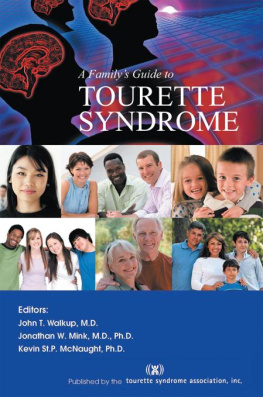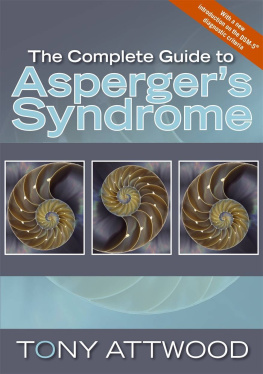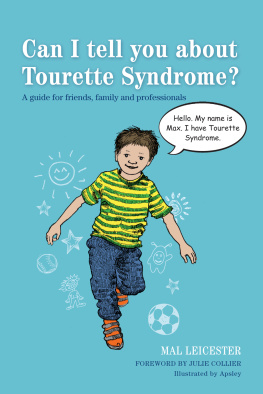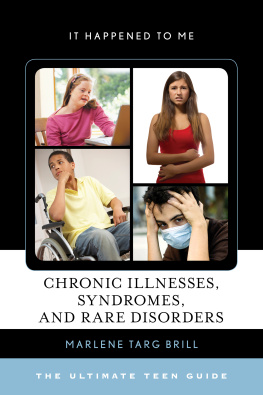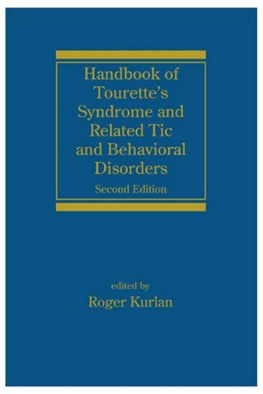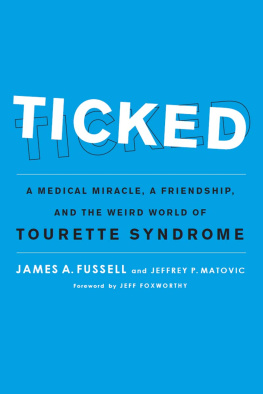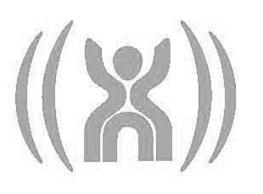
A Familys Guide To
TOURETTE SYNDROME
Editors:
Dr. J.T. Walkup, Dr. J.W. Mink, and
Dr. K. St. P. McNaught
iUniverse, Inc.
Bloomington
Tourette Syndrome Association, Inc.
A Familys Guide to Tourette Syndrome
Copyright 2012 by Tourette Syndrome Association, Inc.
All rights reserved. No part of this book may be used or reproduced by any means, graphic, electronic, or mechanical, including photocopying, recording, taping or by any information storage retrieval system without the written permission of the publisher except in the case of brief quotations embodied in critical articles and reviews.
The information, ideas, and suggestions in this book are not intended as a substitute for professional medical advice. Before following any suggestions contained in this book, you should consult your personal physician. Neither the author nor the publisher shall be liable or responsible for any loss or damage allegedly arising as a consequence of your use or application of any information or suggestions in this book.
A Familys Guide to Tourette Syndrome may be ordered through iUniverse booksellers or by contacting:
iUniverse
1663 Liberty Drive
Bloomington, IN 47403
www.iuniverse.com
1-800-Authors (1-800-288-4677)
- or -
Tourette Syndrome Association, Inc.
42-40 Bell Blvd., Suite 205
Bayside, NY 11361
www.tsa-usa.org
718-224-2999
Because of the dynamic nature of the Internet, any web addresses or links contained in this book may have changed since publication and may no longer be valid. The views expressed in this work are solely those of the author and do not necessarily reflect the views of the publisher, and the publisher hereby disclaims any responsibility for them.
Any people depicted in stock imagery provided by Thinkstock are models, and such images are being used for illustrative purposes only.
Certain stock imagery Thinkstock.
ISBN: 978-1-4620-6857-9 (sc)
ISBN: 978-1-4620-6858-6 (hc)
ISBN: 978-1-4620-6859-3 (ebk)
Library of Congress Control Number: 2012901967
iUniverse rev. date: 08/13/2012
CONTENTS
The national Tourette Syndrome Association, Inc. (TSA) was established in 1972 in Bayside, NY, by a group of parents seeking for themselves and for others a better understanding of what was then an obscure neurological disorder that was affecting their children. The organization has since grown dramatically and remains the only national, non-profit, membership organization of its kind in the U.S., and is now highly regarded internationally. Today, the TSA is arguably the most notable advocate for people touched by this disorder and is perhaps the leading supporter of Tourette syndrome research and education around the world.
During the phenomenal growth of the organization over the past 40 years, we remain committed to our original mission of seeking to increase and disseminate knowledge of Tourette syndrome among people who have the disorder, families, the general public, care providers, scientists, etc. Indeed, these individuals who we sought to serve, as well as many governmental and non-governmental organizations, have partnered in various ways with the TSA to advance the field of Tourette syndrome research and awareness. We also recognize the immeasurable contributions of our membership, generosity of our donors, commitment of our Board of Directors, and the hard work of the many scientists and clinicians, all of whom have a desire to see this complex disorder unraveled.
The TSA has traditionally provided medical and scientific information on the disorder in the form of brochures, newsletters, reprints of journal papers, articles written for us by experts in the field, and more. We will continue producing these sources of information along with this book which was conceived out of a need to consolidate these various publications into a single volume, written in non-technical/lay language, and is intended to become an authoritative and up-to-date source of information on Tourette syndrome for patients, families, schools, support groups, and the public at large. The book is written by highly accomplished and leading neurologists, psychiatrists, psychologists, scientists and others with expertise in many areas of Tourette syndrome investigation and treatment. These individuals themselves have made significant contributions to our understanding of the disorder through research funded by the TSA and other organizations, as well as the NIH and the CDC. There is also a chapter in the book that is written by a mother who shares her experiences in helping her children cope with a disorder that is often difficult to treat with existing medications.
The TSA probably receives more requests for referrals and answers to medical/scientific questions on the disorder through our Information & Referrals service than for any other concern. Over the years, we have asked members of our Medical and Scientific Advisory Boards to respond to these questions in our official quarterly newsletter called Inside TSA . We have concluded this book with a selection of the top 50 frequently asked questions with answers which will be particularly helpful to individuals newly diagnosed with the disorder.
This book is the culmination of many years of commitment, support and research by many individuals touched by or interested in Tourette syndrome. We thank Dr. Arnold Lupin and the Lupin Foundation for their generosity in providing the funds to make this book possible. We hope that you find the information presented edifying, but recognize that this remains a work in progress and there is still much more that we need to learn about this complex disorder.
Reid Ashinoff, Chair, TSA Board of Directors
Judit Ungar, M.S.W., TSA President
Dear Reader,
Well done! You made a great decision when you picked up a copy of this book, A Familys Guide to Tourette Syndrome . Before you plunge in and start turning pages, let me take a few moments of your time to tell you what you are in for. You have in your hands a unique resource for anyone concerned with Tourette syndrome. Perhaps you have thought that beforeonly to find either much less or much more than you wanted to read. But this time it is true, for this is neither another thumbnail of important topics nor a tome suitable only for doctors and researchers. This is something altogether new, an entirely readable but nonetheless comprehensive volume on all things Tourette, written for the well-informed layman.
Why target this group? Well, my life as a Tourette patient, neuroscientist, and long-time member of the Tourette Syndrome Associations Scientific Advisory Board has taught me that Tourette families are nothing if not well-informed! Quite often, the work of the TSA has helped to develop this body of educated laymen, the folks ready and able to learn more about the disorder and to take an active role in treatment, advocacy, and support of research. For decades now, a major part of TSAs mission has been to arm everyone they could reach with the facts about Tourette, and about living with it successfully. And here they are again, lashing together for this volume, a distinguished group of authors that includes many of the finest clinicians and researchers involved with Tourette. So, in 18 concise, authoritative chaptersheres what you have in store:
First, ten chapters cover everything you might want to know about Tourette in the clinical setting. These include a general introduction to Tourette, expert description of how the disorder is currently diagnosed, and what the best practices are for treatment with medication, cognitive behavioral therapy, and other modalities. Also covered are how Tourette treatment can be managed during pregnancy, and even how common we believe it to be, and how we have come to know that. On the research front, three chapters treat the latest results in the science of Tourette. These include a chapter on what makes the structure and function of the Tourette brain unique, another laying out our current knowledge of what the underlying genetic bases of the disorder might be, and the third describing what we understand about the role of autoimmune processes in development and exacerbation of Tourette.
Next page
